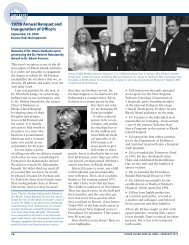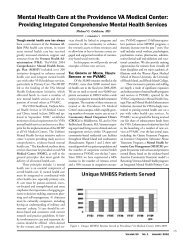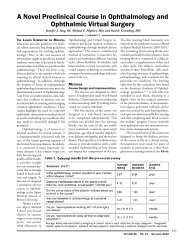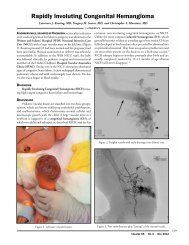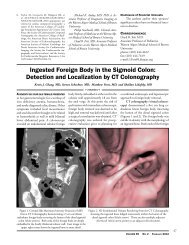Hyperuricemia & Gout - Rhode Island Medical Society
Hyperuricemia & Gout - Rhode Island Medical Society
Hyperuricemia & Gout - Rhode Island Medical Society
You also want an ePaper? Increase the reach of your titles
YUMPU automatically turns print PDFs into web optimized ePapers that Google loves.
ity syndrome (AHS) may occur during<br />
the first three months of therapy. It is<br />
estimated to occur in 0.1% of patients<br />
and has a mortality rate of as high as<br />
26%. 11,12 Signs and symptoms of AHS<br />
include severe exfoliative dermatitis progressing<br />
to toxic epidermal necrolysis, stomatitis,<br />
peripheral eosinophilia, leukocytosis,<br />
fever, hepatitis, and acute renal insufficiency.<br />
There exists no specific treatment<br />
for AHS other than discontinuation<br />
of allopurinol and supportive care,<br />
with the role of systemic steroids unsubstantiated.<br />
13<br />
Patients who develop an allergic reaction<br />
to allopurinol can be treated using<br />
an allopurinol desensitization protocol.<br />
Desensitization, however, should be<br />
attempted only in patients with mild to<br />
moderate reactions to allopurinol ranging<br />
from maculopapular rash, mild fever<br />
to peripheral eosinophilia without any<br />
liver or renal impairment. 11,14<br />
Initial allopurinol dose should be<br />
based on the patient’s GFR. A suggested<br />
starting dose according to creatinine<br />
clearance is provided in Table 1. 15 The<br />
starting dose, however, is often inadequate<br />
to reduce serum urate to target levels. In<br />
a study of 250 patients in New Zealand<br />
who were prescribed a fixed allopurinol<br />
dose based on renal dosing calculator,<br />
only 19% of the study cohort reached a<br />
target serum urate level of less than 6.0<br />
mg/dL. 16 Uric acid levels should be monitored<br />
at six to eight week intervals, and<br />
allopurinol increased until the serum uric<br />
acid is less than 6.0 mg/dL.<br />
Febuxostat<br />
Febuxostat is a non-purine inhibitor<br />
of xanthine oxidase. Because it is dissimilar<br />
from the structure of purines, it does<br />
not interfere with purine and pyrimidine<br />
metabolism. Furthermore, it is degraded<br />
by glucuronide formation and oxidation<br />
in the liver, with half of all febuxostat and<br />
its active metabolites excreted in the stool,<br />
with the other half in the urine. 17 Unlike<br />
allopurinol, febuxostat does not require<br />
renal dose adjustment. 18,19 The major reservation<br />
is its use in patients with underlying<br />
liver disease, current alcohol use, or<br />
history of alcohol abuse, but short term<br />
use of febuxostat 80mg daily for seven days<br />
was demonstrated to be safe in 8 patients<br />
with Child-Pugh A liver disease and 8 patients<br />
with Child-Pugh B disease. 17<br />
In the first phase III randomizeddouble-blind<br />
52-week multicenter trial<br />
of 762 patients with gout with serum<br />
urate levels greater than 8.0 mg/dL<br />
(FACT trial), febuxostat 80mg daily or<br />
febuxostat 120mg daily was compared<br />
with allopurinol 300mg daily. 18 The<br />
study population was composed primarily<br />
of Caucasian men with a mean age<br />
of 51 years. Patients with a creatinine<br />
greater than 1.5mg/dL, any history of<br />
alcohol abuse, or current alcohol use of<br />
more than fourteen drinks a week were<br />
excluded from the study. The authors<br />
found that a higher proportion of patients<br />
in the two febuxostat groups (53%<br />
& 62%) achieved serum urate levels of<br />
less than 6.0mg/dL than patients in allopurinol<br />
controls (21%). Patients receiving<br />
febuxostat also experienced a larger<br />
decrease in tophus size compared to patients<br />
on allopurinol. An important criticism<br />
is that patients given allopurinol<br />
were not allowed dose increases during<br />
the study. This arbitrary distinction underestimates<br />
the true efficacy of allopurinol<br />
in clinical practice.<br />
Adverse events were minor across all<br />
groups. Self limited reactions like diarrhea,<br />
headache, joint discomfort, and<br />
mild elevations in transaminase levels occurred<br />
in similar frequency in all groups.<br />
However, it was noted that significantly<br />
more patients in the febuxostat groups<br />
dropped out of the study and experienced<br />
more acute gout flares. An unexpected<br />
finding was four deaths in the<br />
febuxostat cohorts, as opposed to none<br />
in the allopurinol arm. The cause of<br />
death appeared unrelated to febuxostat<br />
and ranged from congestive heart failure,<br />
metastatic colon cancer complications,<br />
cardiac arrest, and anti-coagulation related<br />
diathesis.<br />
To address some of the concerns<br />
raised in the FACT trial, a 28-week, phase<br />
III randomized-double-blind placebo<br />
controlled trial was completed in 2008<br />
(APEX trial). 19 The same investigators<br />
studied 1,072 gout patients with serum<br />
urate greater than 8.0mg/dL. This study<br />
included patients with creatinine between<br />
1.5 mg/dL to 2.0mg/dL. The demographics<br />
of the study population were<br />
similar to the FACT trial, composed predominantly<br />
of Caucasian men. The authors<br />
looked at five study cohorts: patients<br />
either received febuxostat 80mg daily,<br />
120mg daily, 240mg daily, allopurinol<br />
dosed according to serum creatinine levels,<br />
or placebo. Similar to the FACT trial,<br />
the APEX trial found that febuxostat<br />
reached the primary endpoint of serum<br />
urate less than 6.0 mg/dL in higher proportion<br />
by the end of the study: 36% of<br />
patients on febuxostat 80mg; 52% of<br />
patients on febuxostat 120mg; 66% of<br />
patients on febuxostat 240mg; 10% of<br />
patients on allopurinol; 0% of patients<br />
on placebo. Similar results were seen in<br />
patients with renal impairments. They<br />
were unable to demonstrate a decrease<br />
in tophus size or number due to the short<br />
length of the study. The occurrence of<br />
minor and serious adverse reactions requiring<br />
hospitalization was similar across<br />
study group. Liver enzyme dysfunction<br />
was higher in patients receiving either<br />
febuxostat or allopurinol compared to<br />
placebo controls (19%-25% versus<br />
15%). Unlike the FACT trial, no deaths<br />
were reported during the study.<br />
Though the authors had intended<br />
to study febuxostat in patients with impaired<br />
renal function, only 40 patients<br />
recruited had creatinine between 1.5mg/<br />
dL to 2.0mg/dL. Additionally, patients<br />
with more impaired renal functions were<br />
excluded from this study, as in the FACT<br />
trial. Published data on febuxostat use<br />
patients with renal impairment or hepatic<br />
impairment continue to be lacking and<br />
will require ongoing post-market surveillance.<br />
CONCLUSION<br />
Management of hyperuricemia in<br />
the setting of recurrent or tophaceous<br />
gout has traditionally relied on the use of<br />
allopurinol. Uricosuric agents have<br />
proven utility but are beneficial in a limited<br />
number of situations. Febuxostat as<br />
described here and synthetic uricase as<br />
described elsewhere in this journal are<br />
much welcomed additions to the<br />
rheumatologist’s armamentarium. Experience<br />
with these agents is limited and<br />
their cost-effectiveness remains unstudied.<br />
Therefore, allopurinol will remain<br />
the first line agent for uric acid lowering<br />
therapy. In patients with clinical factors<br />
that preclude the use of probenecid and<br />
in those who had experienced allopurinol<br />
hypersensitivity, febuxostat may prove to<br />
be a valuable alternative.<br />
VOLUME 92 NO. 11 NOVEMBER 2009<br />
361




